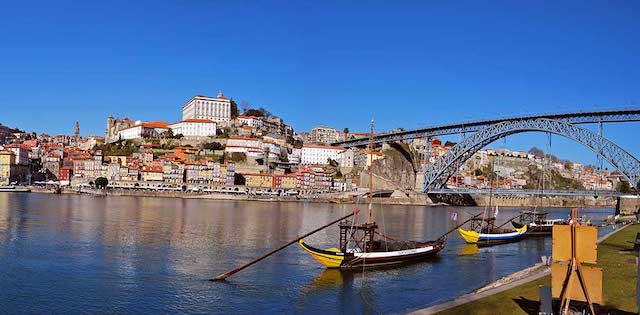The history of Porto city. Did you know that the historic center of Porto has been classified as a UNESCO World Heritage Site since 1996?
Porto is more than just a city. It’s a way of life and a feeling that only those who come here can understand why it’s so special. Mysterious, mythical, and very exclusive, Porto is the second-largest city in Portugal, full of historic monuments, century-old bridges, parks, beaches, the magnificent Douro River, and of course, the Futebol Clube do Porto stadium. Equally important, we have the typical cuisine of the region, including the famous Francesinhas, Tripas à Moda do Porto, and Bacalhau à Gomes de Sá, where we can also include the famous Port wine and much more.
The people
But the most important aspect of this city is its people. Known as the “tripeiros,” they are a joyful, humble, hardworking, fair, and friendly people who are willing to do anything to help those who visit and respect their beloved city. They are undoubtedly one of the wonders of the region.
The Best
In 2001, it was named the European Capital of Culture and in 2012, it was voted as the Best European Destination by the European Consumer Association. Famous for its port wine cellars, high-quality restaurants, and delicious cuisine, Porto also boasts several outstanding cultural venues such as the Serralves Museum, Casa da Música, and the renowned Livraria Lello bookstore.
A vibrant city known for its arts, research, innovation, and entrepreneurship, Porto was voted the Best City Break Destination in Europe in 2020, and the Best European Destination for the third consecutive time in 2017. In 2022, it was considered the Best City Destination in the World.
The best and most fun way to explore the city and the surrounding areas of Porto is by renting a scooter from Love-Scooter, a local rent-a-scooter company. After this brief and current introduction, let’s begin our article on the history of the city of Porto.
The History of the City of Porto
We will be writing a series of articles that will uncover step-by-step the entire history of this fantastic city.
In this article, in addition to talking about the really old beginnings of the city of Porto, we’re also going to discuss in other articles about the Medieval Times, then about Infante D. Henrique, Modernity, Artistic and Urban Renewal, French Invasions, Liberalism, D. Pedro IV’s Heart, September 31st, the Republic, and being a UNESCO World Heritage Site.
Distant Origins
The municipality of Porto, with its current geographical boundaries, is a diverse territory that shows traces of human occupation since prehistoric times – Mesolithic and Chalcolithic – until the Bronze Age and Iron Age, in areas away from the city center, such as Campanhã, Aldoar and Nevogilde.
The Proto-historic
The first traces of the proto-historic castro, which gave rise to the city of Porto, appear on the hill of Sé or Penaventosa, with characteristics similar to other castros in the northwest of the Iberian Peninsula. At the Archaeological Site (Rua de D. Hugo no. 5), objects of daily use and buildings dating from the 4th-3rd centuries BC were found, and nearby discoveries attest to an occupation that dates back to the first centuries of the 1st millennium BC. On Rua de Penaventosa, there are traces of the city wall that surrounded this primitive nucleus.
Casa do Infante
The castro of Cale has commercial connections with the Roman world, presenting a significant level of Romanization in the 1st century AD, probably related to the reorganization implanted by Augustus. In the late Roman phase, the “civitas” expands to the hill of Cividade and the slope of Penaventosa and reaches the Ribeira area, as proven by the archaeological excavations of Casa do Infante and the surrounding area, where there are traces of important buildings inserted in a regular urban network. The growing port dynamics may have strengthened the role of Cale as a catalyst for the regional economy, with the first references to Portucale emerging.
Data taken from interventions throughout the municipality perimeter, mainly along the Douro riverfront, have shown that Roman occupation extended practically throughout the entire territory, reorganized around a new road network structured from two major routes that crossed the Douro towards the North. Evidence has emerged in places such as Miragaia, Massarelos, Cedofeita, Lordelo do Ouro and Foz do Douro.
The crisis
The crisis of 1383-1385 put the city in evidence once again. The king of the “Good Memory” demonstrated a special appreciation for its collaboration in the victory of the war against Castile. Among the most relevant works is the first structured street, Rua Nova or Formosa (now Rua do Infante D. Henrique); the city and its couto become royal; more territories are added to the term of Porto. In this city, he celebrated his marriage to D. Filipa de Lencastre, and his fifth son, Infante D. Henrique, was born and baptized there.


